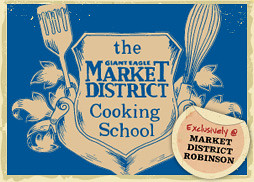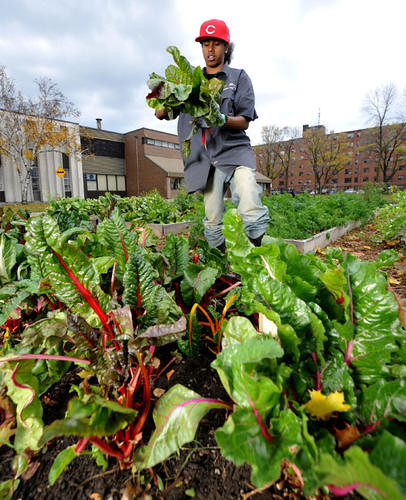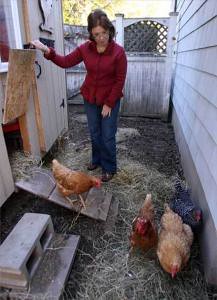Foodstuffs and healthstuff
In the context of wishing there was a lot more innovation in the legislation (FEED DC Act of 2010) before DC City Council concerning improving access to fresh food in areas of the city where there are big gaps (called "food deserts") here's a round robin of interesting stuff.
1. An expanded food cooperative will be opening in West Philadelphia. From the press release for the Mariposa Food Co-op Expansion Project:
Mariposa Food Co-op announced today that it will relocate from its existing storefront to a renovated structure that will provide five times more shopping space and amenities for the West Philadelphia community. After decades in its current location, Mariposa has purchased the landmark Belmont Trust Company Building which most recently served as the home of Beulah Tabernacle Church. Mariposa plans to relocate all of its operations into this new home at 4824 Baltimore Ave by next summer. ...
In the 1970s, Mariposa began as a buying club, providing its membership with high-quality, local and organic food for the last several decades out of a charming, but tiny storefront at 4726 Baltimore Avenue. Following the international cooperative principles, Mariposa is owned and controlled by its members. Since 2000, Mariposa has experienced an unprecedented increase in membership, now boasting over 1000 members. The expansion and relocation will allow Mariposa to grow and meet the demand from the neighborhood.
This is interesting because again, you shouldn't have to rely on the traditional retail market sphere to "deliver" food marketing options in neighborhoods. Food co-ops and other forms of providing grocery markets and options have other benefits in that they can support other entrepreneurship and community building objectives.
2. One thing I have mentioned for many years is the value of connecting food/nutrition/health teaching and demonstration within public markets, so as to better link the idea of preparing fresh foods with nutrition-positive health practices. I have thought about this in terms of the nutrition education programs associated with WIC and Senior Health and Wellness programs, but it could go far beyond that. Toronto's Metcalf Foundation has published a report, In Every Community a Place for Food: The Role of the Community Food Centre in Building a Local, Sustainable, and Just Food System, on the Stop Community Food Centre in Toronto.
From the report:
Over the years, The Stop Community Food Centre in the Davenport West community of Toronto has evolved from a food bank into a thriving community centre where people come together to grow, cook, and eat food, as well as to advocate for measures that can increase food security in the wider community. It maintains its emergency food programs, but has complemented them with a range of capacity- and skills-building programs.
This paper suggests that The Stop can serve as a model for those seeking to address key issues of food insecurity in other communities. The paper incorporates a review of the literature on the social determinants of health and how food programs in general can address them. It also examines evidence gathered by The Stop regarding the impact of its programs in increasing food access and equity, reducing social isolation, and improving health and food skills.
Individual programs similar to some of those at The Stop exist elsewhere, and they generate many benefits. However, this paper argues that it is time to look at larger-scale social investment in building a new type of institution modeled on The Stop’s multi-faceted approach to food security. There is a strong case to be made that a place-based food organization — underpinned by a holistic approach to food security and possessing an adequate physical infrastructure (in order to house a critical mass of staff and programs) — can have a powerful impact on the health and well-being of not only individuals but also larger communities.
This takes my thoughts about incorporating nutrition education and cooking demonstration much further. Imagine a facility like that as part of a public market.
3. But regarding the point about demonstration kitchens in public markets, which I keep making in the context of Eastern Market in DC, why is it that the leading supermarkets understand the need to teach people how to cook when industry trends show (with a slight lessening during the current recession) that people continue to purchase a greater proportion of food/meals out of the home? If you want to sell more fresh unprepared food, you are going to have to teach people how to cook.
The Market District division of Pittsburgh's Giant-Eagle Supermarket chain has a cooking school at one of their suburban locations, and it has quite a schedule of programming.

But Reading Terminal Market in Philadelphia has a demonstration-teaching kitchen, as does the River Market in Little Rock, Arkansas, and of course, so does La Boqueria in Barcelona, Spain.
If it's good enough for Bachelorette parties ("Bachelorette Cooking Parties (Girls Gone Mild!" from the New York Times), it's good enough for the rest of us.
4. But that doesn't mean that we should forget the concept of "community kitchens" as business incubators too. The New York Times Sunday Magazine had a special issue on food a few weeks ago, and the "Consumed" column focused on this, "Shared Tastes."
5. It's also important to consider organizing specific community supported agriculture initiatives to serve the food impoverished. At Green Festival, there was an organization there, Arganica Food Club, promoting an upgrade of how CSAs are marketed--according to their marketing materials, they bring "the weekend farmers market to your door at everyday prices." No reason that can't be done in food desert communities.
6. And why not grow food too, on land that is underutilized. This is big in places like Detroit these days, but I see that there is a "market garden" on the grounds of a school in Toronto, Bendale Business and Technical Institute, according to the article "An edible education" from the Toronto Star. Market gardens produce food and sell it too. (There are some examples of this here and there across the U.S.) And every time I look at the unused greenhouses at DC high schools, I think about how an urban horticulture program could be developed as part of a cooperative or vocational education program in DC Public Schools that could also grow plants for use on the grounds of DC's public buildings.

Anton Crawford harvests Swiss chard in the garden in front of the school. Bendale Business and Technical Institute has Canada's first school-based market garden... another step toward's Toronto's dream of having urban farms within the city. We check it out on a day when they're selling some of their harvest, cooking with it in the cafeteria, and learning about it in their English class. Photos Keith Beaty.KEITH BEATY/TORONTO STAR
I remember a few years ago reading about someone who did this on the grounds of an public housing project I think in DC, and he was charged with a criminal act of converting public goods into personal profit, but somehow, room needs to be made for a broader policy that promotes urban agriculture as well as community economic development and providing people with entrepreneurship opportunities.
7. The Metcalf Foundation has another report on promoting urban agriculture, Scaling Up Urban Agriculture in Toronto: Building the Infrastructure, and this is the kind of report that we desperately need for DC. Note also that Toronto's UTOpia project, publishing thought books on Toronto, innovation, and the future of the region, has a report on food issues, The Edible City: Toronto's Food from Farm to Fork (but I haven't read it), and Toronto's Food Policy is one of North America's most active.
(Also see the Foodprint Project.)

Nancy Murphy's five chickens live in a coop with adjustable electric baseboard heat. Boston Globe photo.
And given the opposition to things like urban poultry in DC, I thought that the chicken coop tours in Belmont ("Chicken Coop Tour?" from the Boston Globe) and Milton ("Everywhere a chick, chick: In suburban backyards, more are discovering the joys of raising chickens" from the Boston Globe) in Greater Boston are a good idea to help people see what urban chicken raising is all about and that it isn't something that they should be frightened about. From the article on Belmont:
Other towns fling open the doors of their most illustrious and historic houses for tours up grand staircases and through fireplaced parlors. But the homes on tour in Belmont this week are smaller than a butler’s pantry. These are simple abodes, although one is equipped with the modern miracle of electric baseboard heat. Another rises upward to a second story. The inhabitants of these houses are chickens.
As freshly laid eggs grow increasingly popular among suburbanites, a fund-raiser in Belmont this Saturday for a new town library provides a chance to see how eight homeowners have incorporated henhouses into their backyard decor.
8. I have written before about the the supermarket/drugstore clinic model is a good one for community and public health. I thought this was a brilliant idea until I read that Christopher Alexander suggested the same thing in the book Pattern Language, published in the late 1970s. Although it's nice to see DC "encouraging" local drugstore behemoth CVS to locate some of these clinics in underserved communities (see "CVS Caremark opens new MinuteClinic" from the Washington Business Journal).
Be that as it may, having community clinics based in communities, focused on helping people with behavioral choices that impact health (i.e., nutrition and other health behaviors) through community education and programming, assisting individuals with managing chronic health care problems such as diabetes (see "Medication adherence: Active Patient Key to Care" from Chain Drug Review), and serving as distribution points for fresh foods would be a good thing. It's too bad something like this idea never made into into the health care bill. Likely something like that will take decades to develop...
9. While people are somewhat taken aback about a proposal to deconstruct a Buffalo, NY church, and rebuild it in a southern town with a growing congregation ("A Georgia parish plans to relocate a church from New York State" from Preservation Magazine), the Limelight Marketplace in New York City demonstrates another way to adaptively reuse underutilized buildings. There, a church was converted into a market building, not for foods, but for crafts. Again, why not add the development of public markets as an option within a "Feed DC" program?
10. It's always worth mentioning the importance of restaurants in seeding commercial district revitalization. Restaurants are particularly important because people eat every day, while they don't buy retail goods every day. So frequency of patronage in a commercial district is stoked by having restaurants there. See "Revisiting Richard's Rules for Restaurant-Based Revitalization" for more on this.
Recent articles, such as about the Rustik Tavern in the Bloomingdale neighborhood of DC ("Welcomed to the neighborhood" from today's Food section in the Post) and about the Slows restaurant in Detroit ("Detroit's Renewal, Slow-Cooked" from the New York Times) remind me about this topic, and the need to provide programs that support restaurants opening in emerging commercial districts. Boston has a program, the Neighborhood Restaurant Initiative, which provides financial incentives and support for restaurants opening in underserved areas. See the 2005 blog entry, "Neighborhood Restaurant Initiative -- City of Boston -- and restaurant-driven revitalization."
Clearly, DC is crying out for a program like that, considering how difficult it is for restaurants to open in emerging areas in the city (with the exception of H Street, but the businessman who has led that effort, Joe Englert, would likely regale you with stories about the trials and tribulations involved).
The article on Detroit also discusses the Eastern Market public market there, and its role as a civic asset and generator of new economic activity around food.
Labels: food-agriculture-markets, public health, restaurants, retail enterpreneurship development, urban design/placemaking, urban revitalization



0 Comments:
Post a Comment
<< Home